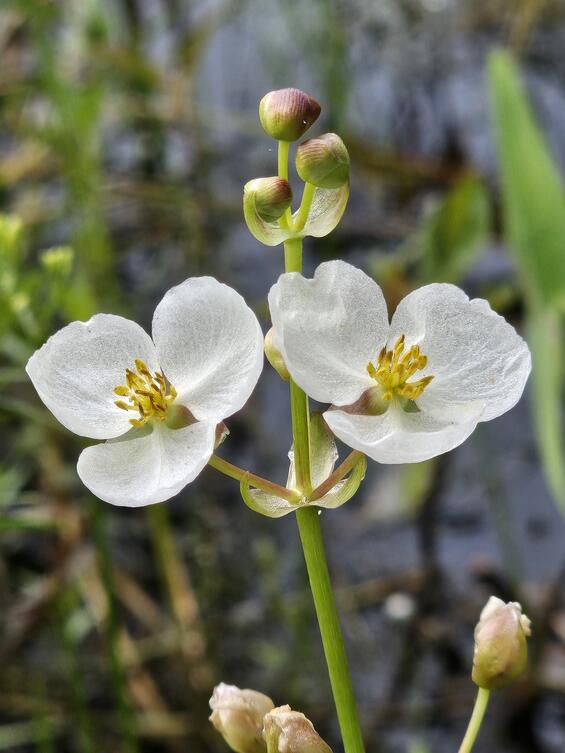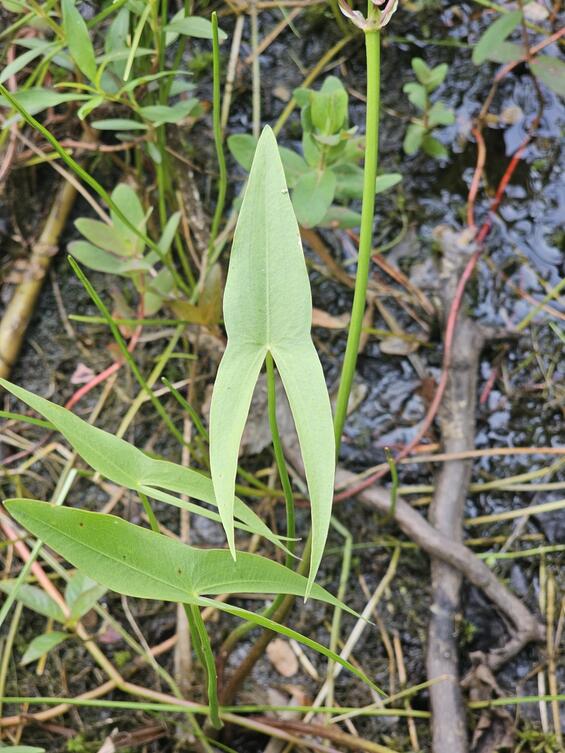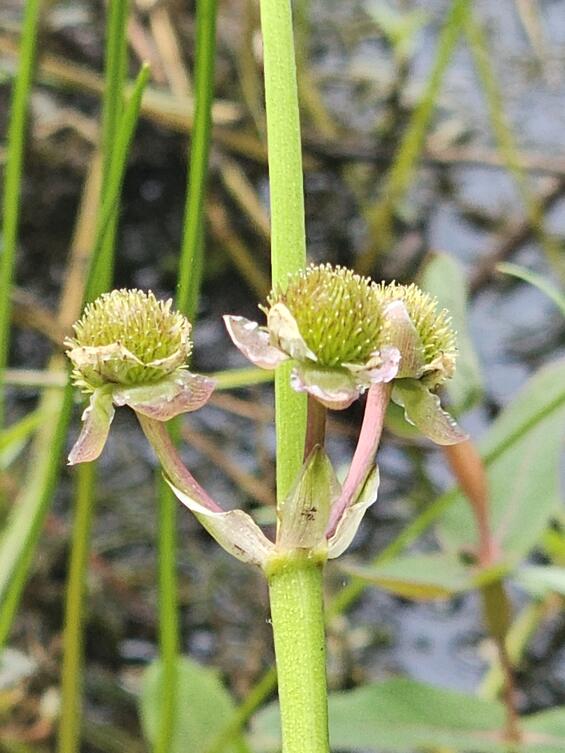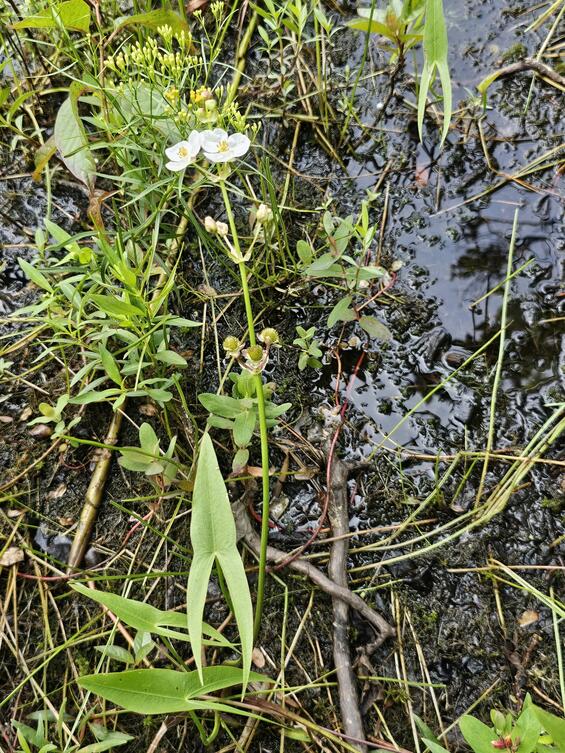- Scientific name: Sagittaria engelmanniana J.G. Small
Species of Greatest Conservation Need (MA State Wildlife Action Plan)
Description

Flower with scarious bracts. Photo credit: Frederick D. Atwood
Engelmann’s arrowhead, Sagittaria engelmanniana, is a perennial aquatic species in the water-plantain family (Alismataceae). It is named in honor of George Engelmann (1809-1884), who was a German-American botanist in the 1800s.
Engelmann’s arrowhead is between 25-80 cm (10-32 in) tall. It has narrow sagittate leaves on long petioles (leaf stems), which typically measure only 4-10 by 0.2-2 cm (1.5-4 by 0.1-0.8 in) The flowering scape is upright with 2 to 4 whorls of flowers; the lower 1 or 2 whorls are pistillate while the upper whorls are clearly staminate with many stamens per flower. The slender filaments of the stamens are mostly longer than the anthers. The fruiting heads are 1-3 cm (0.4-1.2 in) in diameter with achenes that measure 3.6-4.5 mm (0.14-0.18 in) by 2-3.5 mm (0.08-0.14 in) broad, with a beak that is 0.5-2 mm (0.02-0.08 in) long. Faces of the achenes are keeled. The bracts on the flowering stem below each whorl of flowers and fruiting pedicels are scarious (thin, dry and chaff like, not green). The bracts are acute or obtuse, and mostly shorter than the 0.7-3 cm (0.28-1.18 in) long pedicels (flowering or fruiting stems).

Photo credit: Frederick D. Atwood

Immature achenes. Photo credit: Frederick D. Atwood
Life cycle and behavior
Engelmann’s arrowhead is a perennial species that starts to flower in July and will continue through August. The lowest flowers are pistillate ones, and are the first to flower, while the upper whorls of staminate flowers will bloom later. Heads of achenes are present from mid-July to mid-September. It is pollinated by insects. The achenes float on the water surface at least initially and moved by flowing water and wave action.
Population status
Engelmann’s arrowhead has only recently been listed as a species of greatest conservation need (SGCN) and will be maintained on the plant watch list. As it has not been previously tracked the number of distinct populations and current locations in Massachusetts is not known. Engelmann’s arrowhead is an uncommon and declining habitat specialist. It occurs sporadically in sunny pond locations with sandy soil on the coastal plain in eastern Massachusetts. Recent observations in iNaturalist are from Barnstable, Middlesex, Nantucket and Plymouth Counties. Herbarium records indicate that historically it was found in every Massachusetts county except for Berkshire. Two recent county-wide surveys of vascular plants did not relocate it in Franklin County (Bertin et al. 2000) but did find 5 populations in southern and eastern Worcester County (Bertin and Rawinski, 2012).
Distribution and abundance
Engelmann’s arrowhead is known from Vermont and New York south along the Atlantic seaboard to Florida and west as far as Mississippi. It has not been assessed in many states, including in Massachusetts, but many of those that have ranked it note that it is rare or no longer occurs there. In New England, it has never been known from Maine or New Hampshire. It is possibly extirpated in Vermont, and is not ranked in Connecticut, Massachusetts and Rhode Island. New York lists it as vulnerable. It is also possibly extirpated in Virginia, critically imperiled in West Virginia, and imperiled in Delaware, Maryland and North Carolina. Only New Jersey lists it as apparently secure. With maintaining it on the plant watch list, MassWildlife’s Natural Heritage Endangered Species Program (NHESP) should obtain enough information to rank it in the future.
Habitat
Engelmann’s arrowhead is found in acidic waters in freshwater ponds, lakes, bogs and streams with sandy substrates on the Atlantic coastal plain.
Healthy habitats are vital for supporting native wildlife and plants. Explore habitats and learn about conservation and restoration in Massachusetts.

Photo credit: Frederick D. Atwood
Threats
Engelmann’s arrowhead is threatened by changes in hydrology and water chemistry as a result of development, rights-of-way management, canopy closure due to succession, invasive species, and recreational activities. Extreme weather conditions, such as flooding due to excessive rain events or extended droughts may negatively affect this species. Extreme weather conditions are predicted to increase due to climate change (Staudinger et al. 2024).
Conservation
Survey and monitoring
Engelmann’s arrowhead is under-surveyed in Massachusetts. NatureServe (2025) states of this species, “monitoring existing populations is important to improve our understanding of reproduction, plant abundance, threats, and trends, and the effectiveness of conservation measures.” As this species has not been observed recently to the extent expected, and as Massachusetts is at its current known northern extent, it is very important to survey and track the populations of this species. The best time to survey is when the flowers and fruits are present during July and August. Each plant is a separate genet.
Management
Management for this Engelmann’s arrowhead may include opening the canopy over populations and removing invasive plant species. Other threats may be mitigated but have not yet been identified. All active management of rare plant populations (including invasive species removal) is subject to review under the Massachusetts Endangered Species Act and should be planned in close consultation with the NHESP.
Research needs
As this plant is under-surveyed, more standard information is needed such as lists of associated species, comments on habitat quality and threats, and assessments of soil conditions and phenology. Research is needed to determine whether this plant can be grown in a nursery or garden setting for purposes of reintroductions. If habitat degradation accelerates losses of current populations, this strategy could prove useful to long-term conservation of this species.
References
Bertin, R. I, Rawinski, T. J. (2012) Vascular Flora of Worcester County, Massachusetts. New England Botanical Club. 291pp.
Bertin RI, Hickler MG, Searcy KB, et al (2020) Vascular Flora of Franklin County, Massachusetts. New England Botanical Club
Fernald, M. L. 1950. Gray’s Manual of Botany, Eighth (Centennial) Edition—Illustrated. American Book Company, New York.
Gleason, Henry A., and Arthur Cronquist. Manual of Vascular Plants of Northeastern United States and Adjacent Canada, Second Edition. Bronx, NY: The New York Botanical Garden, 1991.
Haines, A. 2011. Flora Novae Angliae – a Manual for the Identification of Native and Naturalized Higher Vascular Plants of New England. New England Wildflower Society, Yale Univ. Press, New Haven, CT.
Herbarium specimen data provided by: [Albion R. Dodgdon Herbarium at University of New Hampshire, Oakes Ames Economic Herbarium at Harvard University, George Safford Torrey Herbarium at University of Connecticut, Woods Hole MBLWHOI Herbarium, NEBC Herbarium at Harvard University] (Accessed through the Consortium of Northeastern Herbaria web site, www.neherbaria.org, 4/2/2025)
NatureServe. 2025. NatureServe Network Biodiversity Location Data accessed through NatureServe Explorer [web application]. NatureServe, Arlington, Virginia. Available https://explorer.natureserve.org/. Accessed: 4/2/2025.
POWO (2025). Plants of the World Online. Facilitated by the Royal Botanic Gardens, Kew. Published on the Internet; https://powo.science.kew.org/ Accessed: 4/2/2025.
Seymour, Frank C. 1969. The Flora of New England, First edition. Charles E. Tuttle Company, Inc. Tokyo, Japan.
Staudinger, M.D., A.V. Karmalkar, K. Terwilliger, K. Burgio, A. Lubeck, H. Higgins, T. Rice, T.L. Morelli, A. D'Amato. 2024. A regional synthesis of climate data to inform the 2025 State Wildlife Action Plans in the Northeast U.S. DOI Northeast Climate Adaptation Science Center Cooperator Report. 406 p. https://doi.org/10.21429/t352-9q86
Contact
| Date published: | May 8, 2025 |
|---|